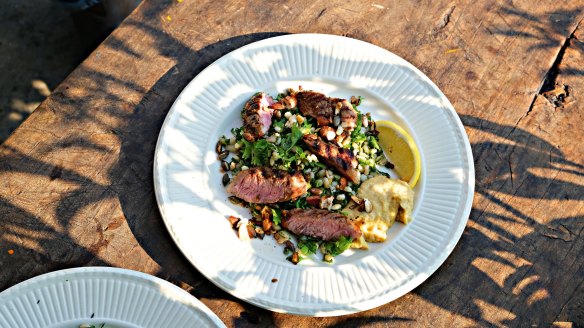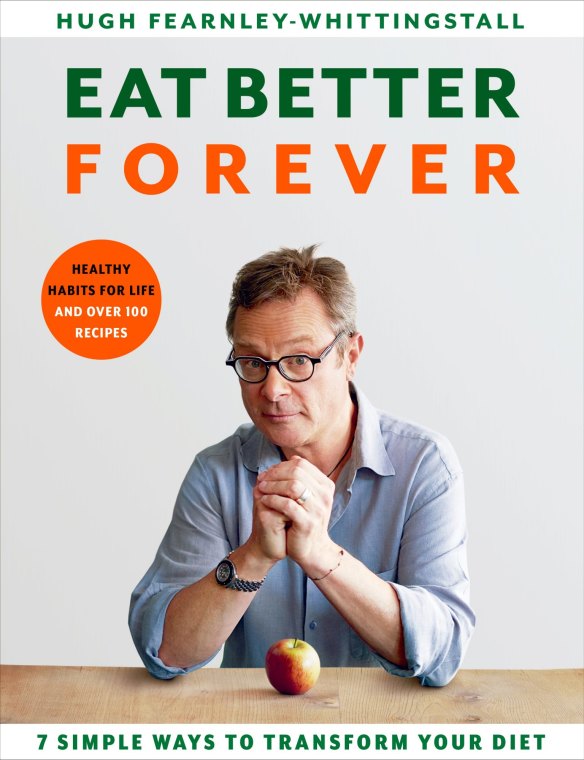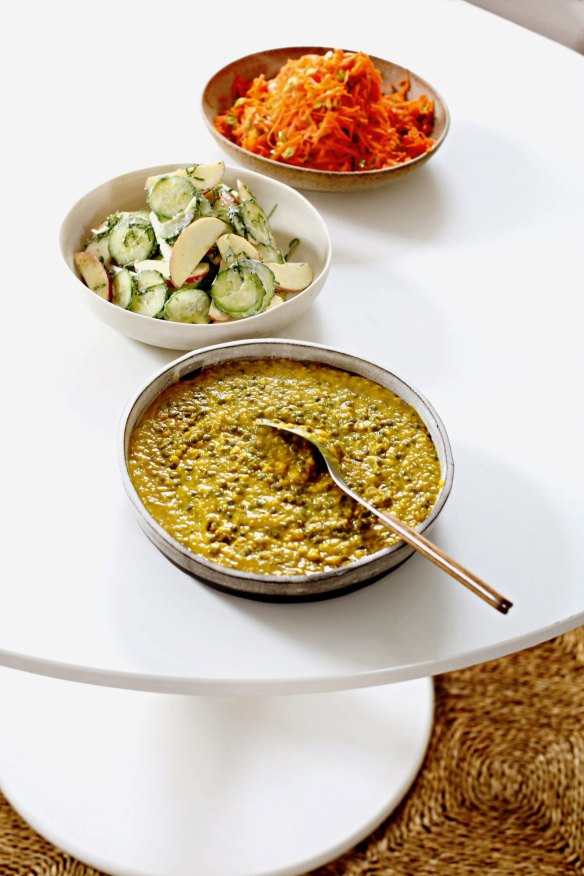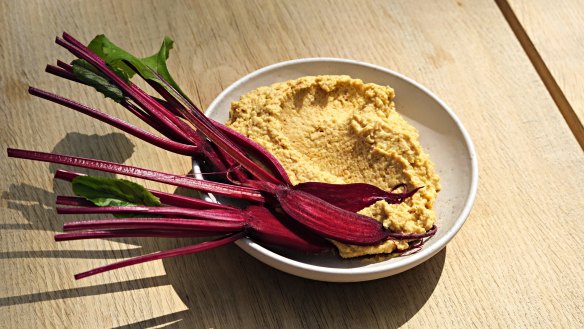Simple summer meals from Hugh Fearnley-Whittingstall's Eat Better Forever

River Cottage chef Hugh Fearnley-Whittingstall is best known for the cookbooks and television series charting his efforts to become a self-reliant, ethical farmer. His latest book, Eat Better Forever, shares seven simple dietary insights based on his in-depth reading and research. They include using whole ingredients, reducing refined carbs and improving gut health.
"Take a few of them on board and you'll be heading in the right direction," he writes. "Pay attention to all seven of them – accumulatively, over time, as it suits you – and you will soon be eating better and feeling better."
Moroccan-spiced lamb steaks with herby barley tabbouleh

This is a lovely way to eat lamb steak: a modest but flavour-packed serving of meat on a zesty, herby tabbouleh. The meat is rubbed with dry spices – if I've got time, I roast whole spices briefly in a dry frying pan and grind them myself using a pestle and mortar, but if I'm on the fly, I'll use ready-ground spices.
INGREDIENTS
- 1 large or 2 medium lamb leg steaks* (about 300-350g in total)
- a little olive or vegetable oil
For the spice rub
- ½ tsp ground cumin
- ½ tsp ground coriander
- ½ tsp ground mixed spice
- a good pinch of hot paprika or cayenne
- a good pinch of salt
For the herby tabbouleh
- 150g pearl barley, pre-soaked if time**
- 1 large bunch of flat-leaf parsley, tougher stalks removed
- 1 bunch of coriander, leaves picked
- 1 small bunch of mint, leaves picked
- 1 small bunch of chives
- grated zest and juice of 1 lemon
- grated zest and juice of ½ orange
- 2 tbsp extra virgin olive oil
- sea salt and black pepper
To serve
- Nutty citrus hummus, warmed (see recipe below)
- dukkah, optional (see recipe below)
- lemon wedges
METHOD
- For the tabbouleh, cook the pearl barley in simmering water according to the pack instructions until just tender (probably 25-30 minutes, quicker if pre-soaked), then drain and leave to cool. Roughly chop the parsley, coriander and mint, and finely snip the chives. Toss the herbs, citrus zest and juice, olive oil and some salt and pepper through the cooled pearl barley. Set aside to allow the flavours to mingle.
- Meanwhile, combine the ingredients for the spice rub. Very lightly oil the lamb steak, then rub the spice mix all over it. Leave for about 30 minutes to come up to room temperature and absorb some of the flavour of the spices. Then gently scrape off excess spice mix so it doesn't burn in the pan.
- Heat a heavy-based pan or griddle over a high heat. Add the seasoned lamb and "dry-fry" for about 3 minutes on each side for nicely pink meat (cook it a little longer if you prefer your lamb medium). Transfer to a wooden board to rest for a few minutes.
- Divide the herby tabbouleh between serving plates. Slice the lamb steaks into roughly 2cm thick slices and arrange on the tabbouleh. Add a generous spoonful of warm hummus and finish with dukkah if you like. Serve with lemon wedges, for squeezing over.
Serves 4
Meat variations
*Lamb leg steaks are available at supermarkets and butchers. Look for lamb rump for the most tender result. Instead of lamb steaks, you could use beef rump steak, spicy lamb sausages such as merguez, or strips of leftover roast lamb – fried and seasoned with the spice mix.
Tabbouleh variations
For a more classic tabbouleh, use cracked burghul wheat instead of pearl barley. Or replace the barley with another cooked whole grain, such as spelt, pearl barley, farro, brown rice or even quinoa.
**Tip: It helps to soak the whole grain first for anything up to 4 hours in cold water. It plumps up the grains, and speeds up the cooking a bit, too.
Double-dhal with carrot and raita salad
Nutty little Puy or beluga lentils are stirred into a freshly cooked dhal to give it extra body and texture, while crisp, raw carrot and a raita-style apple and cucumber salad lend plant-based goodness. Together, they make for a delicious, satisfying and healthy meal.

INGREDIENTS
For the dhal
- 1 tbsp olive or vegetable oil
- 1-2 garlic cloves, sliced
- 1 tbsp curry powder
- 2 tsp cumin seeds
- 200g red lentils, rinsed
- 800ml vegetable stock or water
- 400g can Puy, beluga or green lentils, drained and rinsed, or 250g cooked lentils
- 1 tsp garam masala (optional)
- sea salt and black pepper
For the raita salad
- 2 medium crisp apples
- ½ cucumber (about 200g), sliced
- handful of mint leaves, shredded
- 3 tbsp natural yoghurt
- a scrap of garlic (about ¼ clove), grated
For the carrots
- about 400g carrots, coarsely grated
- 2 spring onions, trimmed and thinly sliced (optional)
- juice of 1 lemon
- 2 tbsp extra virgin olive oil
METHOD
- Set a large saucepan over a medium heat. Add the oil, sliced garlic, curry powder and cumin seeds. Cook gently for a couple of minutes, stirring often.
- Before the garlic browns, add the rinsed red lentils, pour in the stock or water and bring to a gentle simmer. Cook, uncovered, for 20-25 minutes or until the lentils have broken down into a puree and the dhal is nice and thick. Stir the dhal regularly – ideally with a small whisk to help the lentils break down. If it gets too thick, add a splash of water.
- While the dhal is cooking, prepare the raita salad. Quarter, core and thinly slice the apples. Place in a bowl with the cucumber, mint, yoghurt and garlic and turn gently together. In a second bowl, combine the grated carrots with the spring onions, if using, and the lemon juice and olive oil.
- Once the dhal is cooked, stir in the tinned or pre-cooked lentils and cook for another minute or two, then season to taste with a pinch of salt and a twist of pepper. Stir in the garam masala, if you like. Transfer the dhal to a warm serving dish. Take it to the table with the grated carrot mix and the raita salad, and get everyone to help themselves.
Serves 4
Veg variations: Grated raw beetroot makes a great alternative to the carrot here. Raw fennel, very thinly sliced or grated, is lovely instead of the apple in the raita salad.

Nutty citrus hummus
This fresh, zesty take on a classic hummus is great for those who are not keen on the flavour of tahini (though if you are a tahini fan, you can swap it in for the nut butter). You can serve it with any crunchy, raw veg – carrot, celery and cucumber being the most obvious – but don't overlook the possibilities of crisp lettuce hearts, thin wedges of cabbage, cauliflower florets and, as here, young, sweet beetroot.
INGREDIENTS
- 2 x 400g cans chickpeas (or white beans, or one of each), drained and rinsed
- 2 tbsp (about 50g) nut butter, such as peanut or almond
- finely grated zest and juice of 1 lemon
- finely grated zest and juice of 1 orange
- a scrap of garlic (about ¼ clove), grated
- 2 tbsp extra virgin olive oil
- sea salt and black pepper
To serve
- Raw veg crudites, such as carrot, peppers, cucumber, baby beetroot, cut into fingers or wedges
METHOD
- Put the drained chickpeas into a food processor with the nut butter, citrus zest and juice, garlic, a pinch of salt and a twist of pepper. Blitz to a coarse puree, then keep blending, trickling in the olive oil. If necessary, trickle in a little water too, to achieve a loose, spoonable texture. Taste to check the seasoning and adjust if you need to, then it's ready to eat.
Serves 4
Curried roast veg variation
Add leftover roasted root veg, such as carrots, parsnips or beetroot, and a spoonful of curry paste or powder to the processor as you blitz the hummus to make a tasty, textured veg-packed dip. If you like this variation (and you will!), you can even roast some roots especially. Leftovers of almost any veg curry work well, too.
Dukkah
I keep sticking recipes for this nutty, seedy sprinkle in my books because it's just so darned delicious, and is a great way to give some super-healthy dishes an extra boost. Scatter it over salads, seared or roasted veg, soups and dips to add flavour, texture, goodness, and an irresistible hit of spice.
INGREDIENTS
- 30g whole, skin-on almonds or hazelnuts, roughly chopped or bashed
- 30g cashew nuts or peanuts, roughly chopped or bashed
- 30g pumpkin seeds or sunflower seeds, or a mix
- 2 tsp cumin or caraway seeds
- 2 tsp coriander seeds
- 1 tsp fennel seeds (optional)
- a good pinch of flaky salt
- a few twists of black pepper
- a small pinch of dried chilli flakes
- a few sprigs of mint, coriander or rosemary, leaves only, chopped (optional)
METHOD
- Set a small, heavy pan over a medium-high heat. Add the nuts and pumpkin or sunflower seeds to the pan and toast them for 2-3 minutes, shaking the pan regularly so they take on some even colour.
- While the seeds and nuts are toasting, lightly crush all the spice seeds using a pestle and mortar – breaking rather than grinding the spices; leaving a few whole seeds is fine. Add these to the pan of nuts and seeds, along with the salt, pepper and chilli flakes.
- Continue to heat for 2-3 minutes, moving or turning the mix now and then – you're toasting the nuts and spices, almost-but-not-quite burning them (and beware, the small seeds/spices burn quite easily). When done, tip onto a plate and set aside to cool. You can use the dukkah immediately, or store it in an airtight container for a week or so.
Makes 10-12 generous sprinkles
Tip: If you want to add a lovely fragrant note, stir in some of the suggested chopped fresh herbs just before serving. Once you've added the herbs you'll need to use the dukkah within the day, or it will lose its crunch.
Tamari-roasted seed variation
Another lovely seedy sprinkle with an Asian note can be achieved by tossing 150g pumpkin seeds – or a mix of pumpkin seeds, sunflower seeds and broken cashew nuts – with 2 tbsp tamari (or soy sauce). Spread out on a large, non-stick baking tray and toast in the oven at 160C fan-forced (180C conventional) for 10-12 minutes, stirring once or twice, until dark and there is no more liquid tamari visible. As you take the tray from the oven, give the seeds a final stir, then leave to cool and dry. Store and use as above. (Makes enough for 6-8 generous sprinkles.)
This is an edited extract from Eat Better Forever by Hugh Fearnley-Whittingstall, published by Bloomsbury, RRP $40.50, photography © Simon Wheeler.
Appears in these collections
The best recipes from Australia's leading chefs straight to your inbox.
Sign up